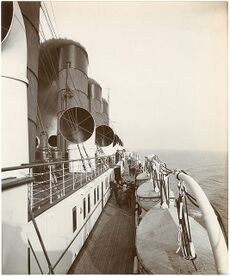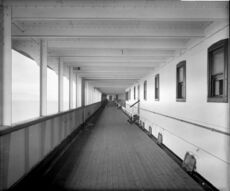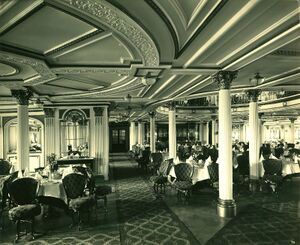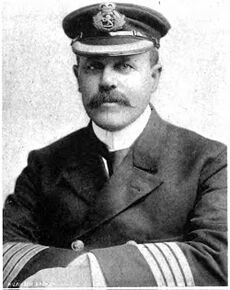PMV California Iron
This article is incomplete because it is pending further input from participants, or it is a work-in-progress by one author. Please comment on this article's talk page to share your input, comments and questions. Note: To contribute to this article, you may need to seek help from the author(s) of this page. |
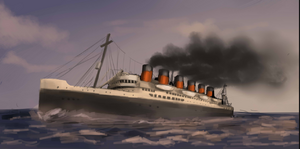 Artists depiction of the PMV California Iron at sea, 1913
| |
| History | |
|---|---|
| Name: | PMV California Iron |
| Owner: |
|
| Port of registry: |
|
| Ordered: | 17 September 1908 |
| Builder: | Morwall Shipyard, Morwall |
| Cost: | $144.5 million |
| Yard number: | 701 |
| Laid down: | 12 July 1910 |
| Launched: | 16 August 1912 |
| Completed: | 27 December 1912 |
| Maiden voyage: | 7 March 1913 |
| Identification: | Radio call sign "CAP" |
| Fate: | Ran onto rocks and sank off the coast of Hatstheput on 11 August 1924. |
| Status: | Wreck |
| General characteristics | |
| Class and type: | Statesman Class Liner |
| Tonnage: | 46,328 GRT |
| Displacement: | 76,310 tons |
| Length: | 922 ft 9 in (281.3 m) |
| Beam: | 92 ft 6 in (28.2 m) |
| Height: | 265 ft (80.8 m) (keel to top of funnels) |
| Draught: | 67 ft 7 in (20.6 m) |
| Depth: | 85 ft 6 in (26.1 m) |
| Decks: | 9 |
| Installed power: | 24 double-ended and ten single-ended boilers feeding four Triple-expansion steam engine/reciprocating steam engines for the wing propellers, and a low-pressure turbine for the centre propeller; output: 46,000 HP |
| Propulsion: | three three-blade wing propellers and two four-blade centre propeller |
| Speed: | Cruising: 40 kn (74 km/h; 46 mph). Max: 45 kn (83 km/h; 52 mph) |
| Capacity: | Passengers: 3,435, crew: 892. Total: 4,327 |
| Notes: | Lifeboats: 20 (sufficient for 1356 people) |
PMV California Iron was a Prybourenean passenger ocean liner that was the largest ship afloat at the time it entered service and was the first and only statesman-class ocean liners built and operated by the Red Town Ship Lines. It was built at Morwall Shipyard in Morwall. The ocean liner carried some of the wealthiest people in the world, as well as providing transportation and tours throughout the Triumvirate powers and Rymoorian Islands. The first-class accommodation was designed to be the pinnacle of comfort and luxury. As a part of their "Two times the luxury, four times the speed" campaign, California Iron boasted not only size and luxury, but double the boilers of most ships at the time. It's six, massive funnels were a highlighted feature of the ship with Red Town boasting that soon it's ships could outclass any of the neighboring competitors.
PMV California Iron is also known as the worst naval disaster in Prybournean history and one of the worst in Anteria history after she failed to make a planned course change, citing poor weather conditions, and hit an underground rock and later sank due to it's damages resulting in the deaths of 1,356 of it's passengers, making it one of the deadliest commercial peacetime maritime disasters in modern history.
Background
The name California Iron was chosen as the final, winning entry to the name. For the Statesman class, Red Town intended to honor local jurisdictions in the state of Newley for their industrial contributions to the country. In this instance, the name was chosen to honoring Las California County's Iron mines.
It was built at San Pablo Shipyard in Newley. California Iron was under the command of Capt. Emmanuel de la Caballería, who had a notable career as a naval officer within Red Town, most notable during his earlier service to the naval power of the then rebels during the Canter Uprising. The ocean liner carried some of the wealthiest people in the world, as well as providing transportation and tours throughout the Triumvirate powers and Rymoorian Islands. The first-class accommodation was designed to be the pinnacle of comfort and luxury. As a part of their "Two times the luxury, four times the speed" campaign, California Iron boasted not only size and luxury, but double the boilers of most ships at the time. It's six, massive funnels were a highlighted feature of the ship with Red Town boasting that soon it's ships could outclass any of the neighboring competitors.
As one of the Fortune Five, Red Town was under pressure to show the world what it could do with its new-found power and influence as a frontrunner and representative of Prybourne. Red Town was also eager to bolster its aging fleet. Red Town maintained many of it's ships from the mid to late 1800s and many of it's of its ships had also been lost during the uprising less than 20 years earlier. With the absence of a modern fleet, Red Town's position within the National Conglomerate soon became under question.
Red Town put their leading designers to work designing the Statesman-class vessels. The design was overseen by Pascual Aguinaldo, a director of Red Town; naval architect Rodrigo Graciani, the managing director of Red Town's design department; Alfonso Andino, Graciani's deputy and responsible for calculating the ship's design, stability and trim; and Ricardo Correa, the shipyard's chief draughtsman and general manager. Correa's responsibilities included the decorations, equipment and all general arrangements, including the implementation of an efficient lifeboat davit design.
Dimensions and layout
California Iron was 922 ft 9 in (281.3 m) long with a maximum breadth of 92 feet 6 inches (28.19 m). Her total height, measured from the base of the keel to the top of the funnels, was 265 ft (80.8 m). She measured 46,328 gross registered tons and with a draught of 34 feet 7 inches (10.54 m), she displaced 76,310 tons.
California Iron had 10 decks, as typical for a Stateman-class ship. These decks included:
Boat Deck
The boat deck was located at the top of the ship and was primarily used to house the lifeboats. The bridge and wheelhouse were located at the forward end of the boat deck, in front of the captain's and officers' quarters. The bridge stood at a height of 8 feet (2.4 m) above the deck and extended out to either side, providing better control of the ship while docking. The wheelhouse stood directly behind and above the bridge, giving a clear view of the surrounding area. Midships on the boat deck was the entrance to the First Class Grand Staircase and gymnasium. The raised roof of the First Class lounge was also located here. At the rear of the deck were the roof of the First Class smoke room and the relatively modest Second Class entrance.
The wood-covered deck was divided into four segregated promenades: for officers, First Class passengers, engineers, and Second Class passengers respectively. Lifeboats lined the side of the deck, except for in the First Class area where there was a gap so that the view would not be obstructed. This meant that the deck space was crowded elsewhere on the ship.
A Deck
This is deck was reserved exclusively for First Class passengers was the epitome of luxury and comfort, with a range of facilities designed to meet their every need. The deck was home to the most opulent cabins on the ship, providing First Class passengers with the ultimate in comfort and luxury. The cabins were spacious, elegantly decorated, and equipped with all the modern conveniences of the time. In addition to the cabins, the First Class deck featured several lounges, smoke rooms, and reading and writing rooms, designed to offer passengers a range of entertainment and relaxation options. The First Class lounge was an opulent space that provided passengers with an elegant and sophisticated atmosphere to socialize, relax, and enjoy the journey.
The lounge was connected to the smoking room by a long gallery, where passengers could smoke, read, or simply relax and enjoy the view. On either side of the first-class lounge were garden lounges. These were tranquil spaces where passengers could relax amid lush greenery and enjoy the beauty of the sea. The garden lounges were designed to provide a refreshing and peaceful space where passengers could unwind and escape the hustle and bustle of the ship's other areas. Exclusive board rooms reserved for Conglomerate members were also available on this deck. These rooms were reserved for the most distinguished and affluent passengers, providing them with a private and exclusive space to conduct business or hold meetings during their voyage.
B Deck
The top weight-bearing deck of the ship which was the crème de la crème of the accommodations, reserved for the most privileged passengers, including the conglomerate members. The deck housed private suites that featured their own exclusive promenades, offering the utmost in privacy and luxury. The suites were exquisitely appointed and designed to provide passengers with a home away from home. In addition to the private suites, there were two restaurants on the deck that provided luxury dining facilities to First Class passengers. The restaurants were renowned for their exquisite cuisine and elegant atmosphere, offering passengers a gastronomic experience like no other.
The promenade on the top deck extended all around the deck house, providing passengers with a breathtaking view of the ocean. The promenade was screened on each side at the forward end for a considerable length by extending the bulwarks up to the "A" deck and fitting large sliding windows, allowing passengers to enjoy the view while remaining protected from the elements. At the after end of the "B" deck, there was a second class smoking-room and drawing room, as well as a cafe. The smoking room and drawing room were elegant spaces that offered second class passengers a taste of the luxury enjoyed by their first class counterparts. Outside the cafe, there was extensive promenading space, providing passengers with a serene and relaxing area to enjoy the ocean breeze. Above the cafe was the boat deck, where lifeboats were stored in case of an emergency.
C Deck
This area was used for a variety of purposes such as storing equipment such as windlasses, capstans, cargo hatches, and cargo winches. These are all essential tools used for loading and unloading cargo from the ship. Additionally, there was a house that enclosed the entrance to the third class quarters located on the deck below. In good weather, the forward part of the deck was also utilized as a promenade for third class passengers. It provided an open area where passengers could stroll and enjoy the fresh air while taking in the scenic views of the surrounding waters.
Moving to the aft end of the ship, which is the rear part of the ship, there was also space for working the ship. This is where the necessary winches, capstans, and gear were stored and used to manage the ship's operations. These tools were essential for steering and maneuvering the ship, especially during rough weather conditions or when navigating through narrow waterways.
D Deck
Extending the full width of the ship. there was a foyer or reception room for first-class passengers located at the forward end of the ship. This area was designed to welcome and greet the first-class passengers as they boarded the ship. The foyer was spacious and well-appointed, offering a comfortable and elegant space for passengers to relax and socialize. Adjacent to the foyer was the first-class dining saloon, which was the main dining area for the ship's most affluent passengers. This grand and opulent room was designed to impress and offered a luxurious dining experience with top-notch service, fine cuisine, and elegant décor.
Moving aft on the ship, there was the second-class dining saloon, which was located between the two galleys. The galleys were the kitchen areas of the ship, where food was prepared and cooked for all passengers and crew. At the extreme aft end of the ship, there was a third-class smoking room and an entrance to the third-class quarters. The smoking room was a designated area for third-class passengers to smoke and relax, while the entrance led to the lower decks where the third-class cabins were located.
On the other hand, at the forward end of the ship, there was a large third-class social hall. This was a communal space for third-class passengers to gather and socialize, offering them a chance to enjoy some entertainment, music, and dancing during their voyage.
E Deck
This deck included several amenities for its passengers, such as a first-class swimming bath and gymnasium. These facilities were located on the deck and provided the first-class passengers with opportunities for exercise, relaxation, and recreation during their voyage. At the aft end of the same deck, there were staterooms for second-class passengers. These rooms were spacious and comfortable, providing a cozy and private space for second-class passengers to rest and relax during their voyage. Additionally, there were large spaces dedicated to third-class promenades. These open areas provided a space for third-class passengers to take a walk and enjoy the fresh air while taking in the stunning views of the ocean.
A passage extending right fore and aft for the use of third-class passengers was also included on the deck. This passage was designed to provide easy access for third-class passengers to move from one part of the ship to another. It allowed them to move around the ship conveniently and comfortably, ensuring that they had a smooth and enjoyable experience during their voyage.
F & G Deck
The lower decks of the ship catered to the third-class passengers, providing them with comfortable sleeping cabins and large dining saloons. These saloons were designed to accommodate the significant number of third-class passengers on board, offering them a place to dine, socialize, and relax during their voyage. The cabins were cozy and provided a comfortable space for the passengers to rest and sleep during the journey. In addition to the sleeping cabins and dining saloons, the rest of the space on these decks was dedicated to accommodating the ship's crew.
The forecastle area was where the seamen, firemen, and trimmers stayed, and it provided them with a functional and efficient space to carry out their duties while at sea. Towards the aft of the ship, there were areas designated for the stewards who were responsible for catering to the passengers' needs. On the starboard side of F deck towards the bow of the ship, there was a mail room. This room was a crucial part of the ship, as it allowed passengers to send and receive mail during the voyage. The mail room was connected directly above G deck with the sorting room and baggage area. This made it easy for the mail to be sorted and distributed throughout the ship, ensuring that passengers received their mail promptly.
Orlop Decks
Below the waterline, the ship housed a range of essential facilities and equipment, including the power plant, food storage, and cargo spaces. Additionally, the area below the waterline contained the ship's engines, turbines, boilers, and electrical generators. These were all critical components that enabled the ship to function efficiently and safely during its voyage.
However, these areas were strictly off-limits to passengers. The design of the ship ensured that passengers were kept safe and that their access was restricted to designated areas of the ship. The lower decks were designed primarily for the crew, who were responsible for operating and maintaining the ship's systems and equipment. Despite the crew's dominance of the lower decks, several areas required access by both crew and passengers. For instance, the deck was occasionally interrupted at several points by the lower Orlop Decks and crew passages.
Crew
California Iron typically had 892 on board for any regular voyage. Like many vessels of her time, she did not have a permanent crew, and most were sign ups which began earlier in the month before voyage. For the final years of her service she was captained by Capt. Emmanuel de la Caballería, a shipping master and naval veteran of the Canter Uprising. The crew were broken up into several distinct groups: Deck, with 73 crew; Engine, with 325; and Services, with 494. The vast Majority of the crew were either engineers, firemen, or stokers, responsible for looking after the engines, or stewards and galley staff, responsible for the passengers. Some other jobs aboard included bakers, chefs, butchers, fishmongers, dishwashers, stewards, gymnasium instructors, laundrymen, waiters, mail clerks, bed-makers, cleaners, shop keepers, and even a librarian.
A few special staff were self-employed or were subcontractors. The A La Carta restaurant and Cafe Parisino were exclusive dining establishments on the B deck, reserved for Conglomerate Executives and their guests. The staff of these restaurants were mostly self-employed or subcontractors, providing a unique and personalized service to their high-end clientele. The A La Carta restaurant was known for its a la carte menu and upscale atmosphere, while the Cafe Parisino offered a more relaxed atmosphere and served coffee, pastries, and light snacks.
In addition to the restaurant staff, there were also musicians employed to perform in the first class restaurants, providing entertainment for the passengers during their meals. These musicians were highly skilled and carefully selected to ensure that they provided a first-class musical experience to match the high standards of the ship and its passengers.
Career
California Iron was put to the test during its sea trials on January 29, 1912. These trials were an essential part of the ship's development process, as they tested its manoeuvrability, compass, and wireless telegraphy. During this time, the ship was put through a series of rigorous tests to ensure that it was seaworthy and ready to take on its maiden voyage. While the sea trials were successful, the ship's owners chose not to conduct a speed test at this time. However, they were confident that the ship would be able to reach impressive speeds, thanks to its powerful engines and innovative design. After the sea trials, PMV California Iron was officially commissioned and began its first voyage, transporting passengers from Prybourne to the Rymoorian Islands.
The ship quickly gained a reputation as one of the most luxurious and sought-after ocean liners of its time, attracting passengers from all over the world. Its maiden voyage in 1913 was a resounding success, with the ship transporting some of the wealthiest people in the world on a journey from Prybourne to the Rymoorian Islands. On board were several prominent businesspeople, including the CEOs of several major corporations. The trip was marked by several lavish dinners and receptions, during which the passengers were treated to the finest cuisine and entertainment. The ship's onboard orchestra played music each evening, and the passengers danced the night away in the grand ballroom. The ship quickly gained a reputation for its luxurious accommodations, gourmet dining, and exceptional service, attracting passengers from all corners of the globe.
Despite its reputation as a luxury liner, California Iron also played an important role in transporting immigrants and other travelers to the other Triumvirate nations. In the early 1910s, the ship made several voyages between Prybourne, Kilowatt, and Velnotia, carrying thousands of immigrants and tourists. While the accommodations for these passengers were not as luxurious as those for first-class travelers, they were still far better than what many of the passengers were used to. In addition to transporting immigrants, the California Iron also served as a vital link between the Triumvirate nations, facilitating trade and commerce between the countries. The ship was often used to transport valuable cargo, such as textiles, spices, and precious metals, between ports in Prybourne, Kilowatt, and Velnotia.
The 1911 renovation was an ambitious undertaking that aimed to further elevate the ship's reputation as the ultimate luxury liner. Red Town Ship Lines invested a significant amount of money and effort into making the ship even more impressive than before, ensuring that it remained a top choice for the world's elite travelers. One of the most notable changes made during the renovation was the expansion and redesign of the ship's first-class suites. The suites were made even more opulent, with luxurious furnishings and decor that reflected the latest in contemporary design trends. Additionally, many of the suites were made larger to provide guests with even more space and comfort during their voyage.
In addition to the expanded suites, a brand new gymnasium was added to the ship. This state-of-the-art facility featured the latest exercise equipment and was staffed by expert fitness instructors who provided personalized training and fitness programs to passengers. The gymnasium quickly became a popular feature among passengers, who enjoyed the opportunity to stay in shape while at sea. Other new amenities added during the renovation included a movie theater, a larger swimming pool, and a redesigned promenade deck that provided even more space for passengers to relax and take in the stunning views of the open sea.
In 1921 California Iron experienced a storm that was one of the worst on record at the time, and it proved to be a true test of the ship's strength and stability. Despite the dangerous conditions, the captain and crew were able to maintain control of the ship and keep it on course. Passengers on board described the experience as both exhilarating and terrifying. The ship was tossed about by the violent waves, and many passengers feared that they would be swept overboard or that the ship would capsize. However, the ship's sturdy construction and advanced technology allowed it to withstand the punishing conditions. As the storm raged on, the passengers and crew huddled together for safety, seeking refuge in the ship's many lounges and dining rooms. Despite the chaos and danger outside, the mood on board remained surprisingly upbeat, with passengers and crew alike commending the ship's strength and stability.
Disaster
On the 31st of July, 1924, the California Iron departed on her 22nd voyage from Santa Famidonia in the Rymoorian Islands, carrying 2,325 individuals, including 1500 passengers. Among the passengers were some of the wealthiest people in the world, who had come aboard to experience the pinnacle of comfort and luxury that the ship had to offer. On the day of the disaster, the California Iron was making its way through the Rymoorian Islands when it encountered a sudden and severe storm. The ship was designed to withstand rough seas, but the storm was more intense than the captain and crew had anticipated. As a result, the captain made the decision to alter the ship's course, taking it on a new route that would avoid the worst of the weather.
As the storm worsened, the California Iron was tossed about by the wind and waves. The ship was designed to withstand rough seas, but the storm was more intense than anticipated. Despite the best efforts of the crew, the ship began to drift off course, and the captain realized that they would need to make a change to avoid the worst of the weather. The captain ordered the ship to change course, directing it towards a safer route. However, there was a miscommunication among the crew, and the ship failed to make the planned course change. Instead, the ship continued on its original path, putting it on a collision course with an underground rock formation. As the ship approached the rocks, the crew realized their mistake and attempted to take evasive action. However, it was too late, and the ship collided with the rocks with great force. The impact caused significant damage to the ship's hull, and water began to flood into the lower levels of the vessel.
Capt. Caballería quickly ordered a full stop to the engines and directed the crew to inspect the damage. As the crew inspected the damage, they quickly realized that the situation was dire. Water was flooding into the lower decks of the ship, and it was becoming increasingly clear that the California Iron would not be able to stay afloat for much longer. In response to this, Capt. Caballería quickly ordered the crew to begin evacuation procedures. The Capt. Caballería gave orders to launch the lifeboats and instructed the crew to help the passengers to safety. However, the evacuation efforts were hindered by a number of factors. Firstly, the ship did not have enough lifeboats to accommodate all of the passengers and crew, meaning that many were left stranded on the sinking vessel. Additionally, the chaos and panic that ensued as the ship began to sink made it difficult to conduct a coordinated and efficient evacuation.
The situation onboard California Iron was made even more chaotic by the fact that the ship's wireless equipment had been damaged in the collision with the rock, leaving the crew unable to send out a distress signal to other ships in the area. The captain and crew were forced to rely on traditional methods of signaling for help, such as sending up flares and using semaphore flags to try and attract the attention of passing ships. As the ship continued to take on water and list to one side, the crew struggled to maintain order and get the passengers into the lifeboats. Some of the lifeboats were launched without proper supervision, and many became overcrowded, causing some to capsize and others to become tangled in the ship's rigging.
As the California Iron continued to take on water, the crew desperately tried to keep the ship afloat while simultaneously continuing evacuation efforts. However, the damage sustained in the collision was too severe, and the ship began to sink at an alarming rate. Despite the crew's best efforts any passengers were left stranded on the sinking ship or forced to jump into the water to try to swim to safety. The lack of lifeboats on the ship was also a significant factor in the loss of life. The crew worked frantically to rescue as many passengers as possible, but with the ship sinking rapidly, their efforts were ultimately in vain. As the ship slipped beneath the waves, many passengers were left clinging to debris in the water, struggling to stay afloat.
The SS Jubilee, a passing ship, was finally able to spot the wreckage of the California Iron several hours after the collision had taken place. The crew of the Jubilee immediately launched their own lifeboats to assist in the rescue of survivors. Many of those who had managed to board the lifeboats were quickly picked up by the crew of the Jubilee, but tragically, many others had already perished in the disaster. The disaster claimed the lives of many passengers and crew members, including the highly respected Capt. Caballería and several other senior officers. The final death toll was staggering, with 1,356 people perishing in the disaster.
Aftermath
The sinking of the California Iron was a tragedy that shook the world and raised many questions about the safety and preparedness of ocean liners of the time. The loss of so many lives was a devastating blow, and it was a reminder of the inherent dangers of travel by sea. The disaster raised many questions about the preparedness of ocean liners of the time and the standards of safety they adhered to. Critics argued that the lack of adequate lifeboats on the California Iron was a significant factor in the loss of life. The fact that the ship's wireless equipment was damaged in the collision and that it took several hours for another ship to spot the wreckage and come to the rescue further highlighted the inadequacies in the safety measures in place at the time.
An inquiry was launched to investigate the cause of the disaster and to determine whether any negligence or wrongdoing had occurred. The inquiry was led by a panel of experts and included testimony from surviving crew members, passengers, and other witnesses. The inquiry ultimately concluded that the primary cause of the disaster was the ship's failure to properly navigate the dangerous waters of the Rymoorian Islands, which resulted in the collision with an underground rock. The lack of adequate lifeboats on the ship was also identified as a contributing factor to the loss of life. The findings of the inquiry led to significant changes in maritime safety regulations and practices, including the requirement for all ships to carry sufficient lifeboats for all passengers and crew and the establishment of stricter guidelines for navigating dangerous waters.
The inquiry also led to the development of new technologies and safety procedures for ships, including new ways to detect underwater hazards and the implementation of emergency drills and training for crew members.

